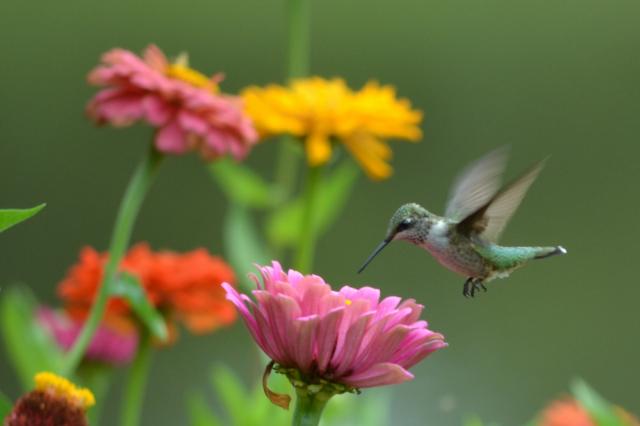Journey
South News

Week #11: October 31, 2014
Just 41 reports this week, totally 81 stragglers and/or resident hummers, indicate migration is nearly over. Thanks to all Journey South citizen scientists who put more than 5,500 sightings on our map. This is the final fall report, but the map remains live throughout fall and winter. Watch for stragglers, check our Fall Feeder Tips, and keep reporting to document where hummers are present!
Image: Marie Paule Lessard

Week #10: October 24, 2014
Numbers and sightings continue to drop, with just 198 hummingbirds—about half as many as last week—reported by Journey South observers. Most of those hummers were found between 29-31 degrees latitude. Migration is tapering off as hummers wing their way to the tropics.
Image: Kathryn Figueroa

Week #9: October 17, 2014
A big dip in sightings signals a slowdown in the journey south. This week brought just half the number of reports and almost 60% fewer hummers than last week. Most reports are single-bird sightings, and many people are reporting their latest hummingbirds ever.
Image: Deborah Repasz

Week #8: October 10, 2014
While rain and wind stalled hummingbirds in some areas, tail winds helped push the northerners south in two distinct waves. Very few hummers now remain above 43 N.
Image: Pamela Karlson

Week #7: October 3, 2014
Single-bird reports dominated in a week when both hummer sightings and numbers took a dive. Observers reported more random and less frequent sightings as October cool fronts and showers sent hummers south. Keep your feeders up: Stragglers are sure to come.
Image: Deborah Repasz

Week #6: September 26, 2014
Sightings are fewer and farther between in the north, and hummers are still arriving at the Gulf Coast. The migration's leading edge has not changed much from 41-42 degrees, but the number of reports (and therefore number of total hummers seen by our observers) is down 35% from last week.
Image: Patrick Hughes

The southward push continues! Having led the way south, males now represent just over 10 percent of sightings reported. Hummer numbers are building in the mid latitudes and also near the Gulf Coast. Once there, will the tiny birds continue over land—or over sea?
Image: Russ Thompson

Along the migration trail, observers report male departures and signs that females and juveniles are preparing to go. With temperatures dropping to unseasonable lows an exodus from the north should soon follow. Meanwhile, southerners are starting to see the BIG numbers of peak migration.
Image: Amy Evoniuk

Migration is building as more and more hummers head south. Summer residents are moving on and new visitors are stopping briefly at flowers and feeders. Also this week, the first report from Mexico of a Rubythroat migrating through. Meanwhile, the Gulf states are readying for massive arrivals.
Image: Glenna from Mississauga, Ontario

Week #2: August 29, 2014
As August ends, observers in the north are already seeing fewer adult males. The females and juveniles left behind now face less competition for food. Fall-blooming flowers like spotted jewelweed are providing essential fuel for migration.
Image: Kristy Walker

Week #1: August 22, 2014
Report your observations as hummingbirds travel from your backyard to their wintering grounds. With your help, we'll make a migration map to show where hummingbirds are present from August through November.
Image: Amy Evoniuk

Explore previous migration seasons:
Image: Vicky Floyd